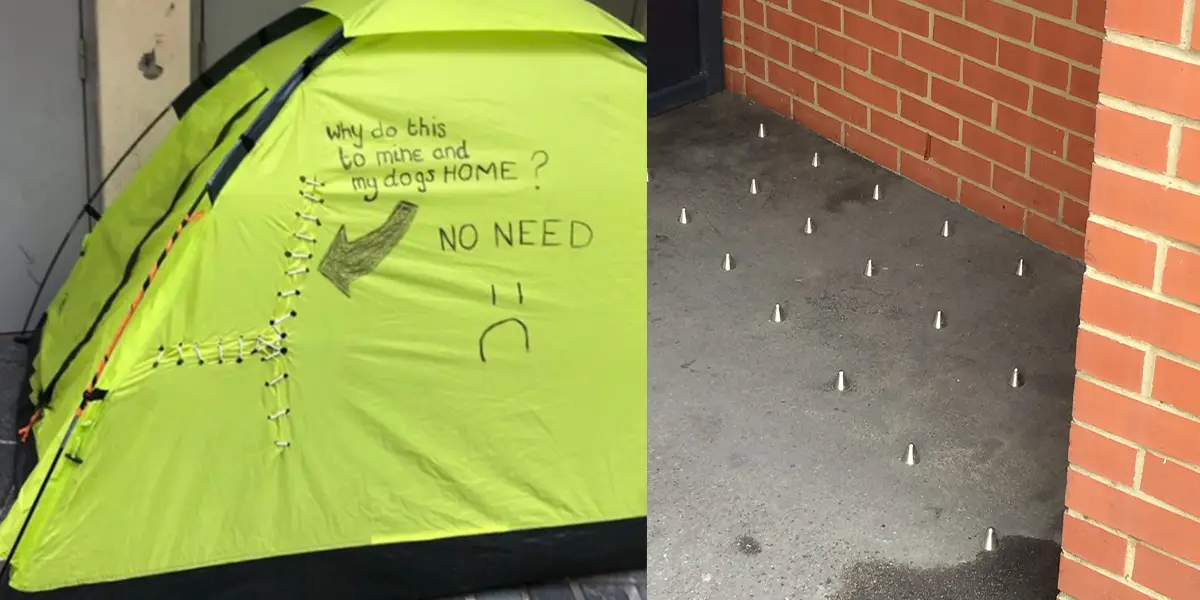These Photos Show How Hostile And “Anti-Homeless” Architecture Are Becoming In Cities
Tags: opinion

The problem of homeless people is growing in all major cities in the world. With the current pandemic and its effect on the global economy, this situation is poised to get worse. As if their lives were not terrible enough, many city councils go out of their way to create “anti-homeless” architecture to keep them off the streets.
SUBSCRIBE TO TRUTH THEORY YOUTUBE CHANNEL, CLICK HERE
Anti-homeless architecture is also known as hostile or defensive design, that deters homeless people from sleeping on flat surfaces in public areas. Not just homeless people, hostile architecture also prevents young people loitering in common areas for too long. Skateboarders are discouraged from using such public places too.
Here are some examples from around the world how anti-homeless” architecture is making lives difficult.
Anti-homeless Architecture: Slanted Benches
Metro stop bench is tilted so attempting to lay down ends up with you sliding off. from r/HostileArchitecture
Slanted benches are put in train stations and bus stops and are extremely uncomfortable. Homeless people seek benches to rest and cities have found this design to tackle them. While the benches serve their purpose of allowing commuters to rest, that rest won’t last long.
Benches with Armrests
Armrests for comfort. Totally not to stop homeless people lying down… from r/HostileArchitecture
Spotting “anti-homeless” architecture needs a trained eye. What you perceive as simple armrests on those public benches also contribute to the hostile design. They prevent homeless people from sleeping on those benches.
Uneven Pavements
To someone homeless & sleeping rough, this hostile architecture makes sure they aren’t sleeping here. Learn more about the impact of defensive architecture beginning tomorrow in ‘Homeless in a Hostile City’, our 10-part tale, online at https://t.co/UT0UdT7wW3 #defensiveTO pic.twitter.com/fMfOHhw4kw
— Haven Toronto (@HavenTorontoCA) May 17, 2018
Rocky and uneven pavements are quite common under awnings and bridges.
Spikes on Windowsills
All those nice arm rests on outdoor benches aren’t there to make you comfy; they’re part of a trend of “hostile architecture”: https://t.co/71n1tMCmG1 @newscomauHQ
— Benedict Brook (@BenedictBrook) April 18, 2018
Spikes are usually used to keep birds away. But they also keep people away people hanging around private property.
Hey, are you on Instagram? Check out the official Truth Theory Instagram page HERE, we upload new content every day.
Our war on wildlife: now birds are not allowed in trees…?! Pigeon spikes spotted in Clifton, Bristol above a car park. Has anyone seen this before? How is it allowed?!
📷: thanks to Anna Francis pic.twitter.com/NuG9WvYBMj— Jennifer Garrett (@JMAGarrett) December 18, 2017
Here are some examples of such anti-homeless architecture spotted by concerned citizens in their locality. It is the responsibility of governments and cities to take care of their less-privileged members. Just because such architecture removes the homeless from the common view does not mean they stop existing.
Read: AUSTIN TEXAS IS PROVIDING EMPLOYMENT TO THE HOMELESS PEOPLE TO GET THEM BACK ON THEIR FEET
@CaraChellew Unsure if this example fits within #defensiveTO but nevertheless. South entrance of TGH on Gerrard. Used to be horiz. flat ventilation grate level with ground; homeless slept on it for warmth. A few months ago the grate was reno’d with a slope. This failed to… 1/2 pic.twitter.com/bsO55IDByh
— Nathan Ng (@nathanng) February 24, 2018
Earlier today, Jason, the man who sleeps in front of the Tim Hortons at Victoria and Dundas streets said police asked him to move across the street so these planters could be installed. The other side of the street is not sheltered from rain or wind. Story to come. pic.twitter.com/8HkH2pqGwu
— The Eyeopener (@theeyeopener) March 22, 2018
I like to think that we are better than this.
Architecture that discriminates against an already marginalized population is the laziest way to address the issue of homelessness. If we, as a public health provider, resort to doing this, what kind of example are we setting? pic.twitter.com/7akZlcKhIh
— Mark Iantorno (@iantoryes) March 29, 2018
Instead of spending money to create such designs in public areas, governments can utilize this money to provide housing and other necessities for the homeless. Many organizations are protesting against such anti-homeless architecture. Some cities are actually taking the initiative to provide for their homeless population and we hope others take note as well.
Leave Comment: